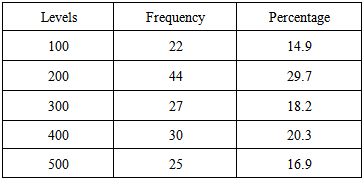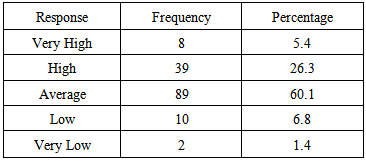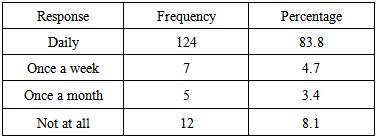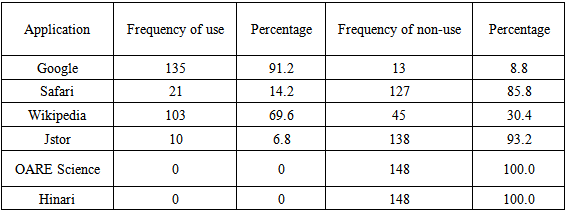-
Paper Information
- Paper Submission
-
Journal Information
- About This Journal
- Editorial Board
- Current Issue
- Archive
- Author Guidelines
- Contact Us
International Journal of Library Science
p-ISSN: 2168-488X e-ISSN: 2168-4901
2015; 4(4): 65-72
doi:10.5923/j.library.20150404.01

Use of Mobile Phones for Academic Purposes by Law Students of Igbinedion University, Okada Nigeria
Philomina A. Mamudu1, Abiola O. Oyewo2
1Kenneth Dike Library, University of Ibadan, Ibadan, Nigeria
2Law Library, Igbinedion University, Okada, Nigeria
Correspondence to: Philomina A. Mamudu, Kenneth Dike Library, University of Ibadan, Ibadan, Nigeria.
| Email: |  |
Copyright © 2015 Scientific & Academic Publishing. All Rights Reserved.
This work is licensed under the Creative Commons Attribution International License (CC BY).
http://creativecommons.org/licenses/by/4.0/

Extensive literature review has shown that the 21st century youth is techno savvy, hence spend quality time surfing the internet using their internet enabled phones. This paper intends to investigate the extent to which students of the College of Law, Igbinedion University use their mobile phones for the purpose of helping them get academic information. The paper investigates how often the students use the internet on their mobile phones and what interest them most on the internet. It aims to determine how often they visit the internet for academic purpose. Five research questions were determined and tested with questionnaire serving as the main instrument for data collection. A total of 150 questionnaires were distributed and all 150 were duly filled and returned, out of which 148 was found usable, representing 98.7% of the representative total population. The analysis of the students ‘perception showed that majority of the students use their mobile phones to search for academic information. The paper also finds out that after academic information, the next highly used function of the mobile phone is for social networking, chatting and reading the news online. It concludes by recommending introduction of mobile learning in the university.
Keywords: Mobile Phone, Internet, Academic Purpose, Nigeria
Cite this paper: Philomina A. Mamudu, Abiola O. Oyewo, Use of Mobile Phones for Academic Purposes by Law Students of Igbinedion University, Okada Nigeria, International Journal of Library Science, Vol. 4 No. 4, 2015, pp. 65-72. doi: 10.5923/j.library.20150404.01.
Article Outline
1. Introduction
- The use of mobile phones for socialization via various social media like Facebook, Whatsapp, Tweeter, LinkedIn, etc cannot be over emphasized. Students use various kinds of internet enabled phones like iphone, blackberry, nokia, samsung and various kinds of android phones for the purpose of socializing on the internet and also to keep abreast of information around them. Adaja & Ayodele (2013) advocated that one of the breakthroughs in information and communication technology in the 21st century was the discovery and emergence of the new media which have facilitated the creation of the different platforms for social interaction. Ayub, Hamid and Nawawi (2014) who share similar views with Adaja & Ayodele (2013) opined that advances in computer technology have enabled the Internet to serve as a platform not merely to seek information, but also to exchange ideas and knowledge with other users, and obtain expert opinions via email, teleconferencing, chatting and other avenues. Nevertheless, the advent of social network sites such as Facebook, Twitter, LinkedIn and others that include chatting and online games have changed the perception on Internet use from one that is associated with learning to that of a socializing facility. Such website applications have resulted in the Internet being used for both academic and non-academic activities”.The 21st century youth spend more time on the phone, the internet or in front of the television screen. The mobile phone usage pattern of youths has become worrisome because most of them use their phones excessively. Livingstone and Bober (2005) opined that youths found mobile phone valuable and useful than any other means of communication. They further noted that mobile phones are sometimes a tool for social identity than a means to facilitate education.Sofowora (2011) shares similar opinion with Livingstone and Bober (2005) when he observed that the indiscriminate use of phones in public places such as the highway, hospitals, churches and even classrooms are other examples of poor mobile phone etiquette. It is not only in Nigeria that these kinds of problems occur, it is world over. It is therefore justifiable to say that if such time spent on the internet is for academic purpose, then probably, the academic performance of youths may gradually be improved and reading culture may be enhanced. The internet can be used for different purposes, depending on the needs of users at the time of visit. Since the use of mobile phone to access the internet is common among the youths, it will be difficult to monitor or censor what is being done on the internet by them.According to Longe et al. (2007), the internet is both a source of promise for our children and a source of concern. The promise is that the internet offers such an enormous range of positive and educational experiences and materials. This paper would reveal the frequency of mobile phone usage for internet activities and what is being done on the internet by the selected sample, in a bid to investigating the frequency of use of the internet for academic purposes.
2. Objectives of the Study
- The main objective of the study was to investigate the extent, to which mobile phones are used by students of the College of Law, Igbinedion University, Okada to do their class work and to consult academic documents relevant to their field of study.The study aimed at identifying the following:1. The mobile phone practices of the students.2. The number of hours students spends on social networks, playing games, chatting, shopping online, gambling online, reading news and doing academic research.3. The number of students that use their phone for academic purposes.4. The academic applications that the students make use of.5. How convenient it is to use the mobile phone for academic purposes.The research will help to have a clear understanding of students’ mobile practices which would encourage the university to implement more student-centered support and services.
3. Research Questions
- To achieve the above stated objectives of the study, the following research questions were raised1. What are the mobile phone practices of the students?2. What are the numbers of hours the students spend on social networking, playing of games, chatting, shopping online, gambling online, reading news or doing academic research?3. What percentage of the students’ population uses their mobile phone for academic purpose?4. Which academic applications do the students make use of?5. What are the limitations of using mobile phone for academic purposes?
4. Review of Relevant Literature on M-Learning and the Use of Mobile Phones in Education
4.1. Mobile Learning
- Mobile learning has become a major focus in education, mobile technology has really changed the way people learn and want to learn, the learning environment is gradually shifting from the physical to the virtual, the onus now rests on educators to harness from the benefits of mobile learning and also tackle the various problems posed by this new way of learning. This is evident in Irina (2011), learning and communication are becoming increasingly mobile, and the advent of Web 2.0 technologies is actively dissolving the boundaries between “educational” and “real world technologies.” The relationship between users of modern technologies and educational institutions is going through fundamental changes, and it becomes harder on the institutional level to ignore the impetus from the outside world. In the same vein, Tomei (2005) noted that the rapid growth in Information Communication and Technologies (ICT) nowadays has brought amazing changes to various fields, including education. Presently, there is a substantial increase of technological utilization for educational purposes. With the potentials ICT offers, educational institutions are now seeking for new paradigms to restructure their educational curricula and classroom facilities to bridge the existing technology gap education. This process however requires effective adoption of technologies into existing environment in order to provide learners with the required knowledge as well as to promote meaningful learning”.
4.2. Mobile Phone in Education
- The use of mobile phones for education has both its positive and negative sides. Rismark et al (2007) found out that sometimes, students used the mobile phone to view the videos ahead of lectures without further preparation. The mobile phone thus worked as a preparation tool for the purpose to familiarize themselves with the topic without using other study material. Sofowora (2011) further elucidated that mobile communication device no doubt had impacted education positively and negatively. The school as part of the agencies of socialization is not left out. Nigeria as a developing country welcomes mobile technology with enthusiasm. However the enthusiasm soon began to fade out as a result of myriad problems associated with the use of mobile phone by students in schools. Some of the problems are: concern for discipline, examination malpractices and mobile bullying. Research has also shown that some people have become addicted to their phones, they cannot do without it, and they sleep and wake up with it beside them.The emergence of several chat engines like whatsapp, google chat, ebuddy, etc. has made it almost impossible for some people to part with their phones. This is opined in Ezemenaka (2013), some people can experience withdrawal symptoms typically associated with substance abuse, such as anxiety, insomnia, and depression, when they are without their smartphones and all these are embedded to the cause of academic relapse of students who fall into this category. Surprisingly, these addictions take strong toll on the student without them noticing it and some of them find it hard to believe that they are addicted to their phones. Thus, giving more credence to the amount of time meted out to these phones than academics. If such time spent on the internet is used to harness the academic opportunities or content available on the internet, students’ academic performance will be improved.It is worrisome to note that some youths spend a considerable time of their student life on the internet, doing other things than performing academic activities. This is made known in the research conducted by Noor (2003) on the students in University Malaya in Malaysia, she found that students used the Internet for communication, online purchasing, assignments, personal activities and searching academic resources. Students also used the Internet more for social and entertainment purposes than for academic activities. Also, Evans (2008) observed that majority of university students around the world carry these miniature computing and communication devices during the university day, using them almost exclusively for personal purposes. In another research conducted by Omotayo (2006) it was found that among 664 undergraduate students at the Obafemi Awolowo University, Nigeria, 97.1% used the Internet for e-mail and 53.9% for academic information.The average 21st century student is versatile in mining information from the internet; they tend to pick interest in online activities and would tend to do same if they get to know about academic contents on the internet. This point is buttressed by Attewell (2005) previous studies have found out that mobile technologies make a useful contribution to attracting young people to learning, maintaining their interest and supporting their learning and development.In another research carried out on the use of mobile phones in Japan to teach English as a Second Language (ESL) by Thornton and Houser (2004) it was reported that mobile phones in Japan outnumber PCs five to one, and that while 43 per cent of Japanese students use a computer to send email, 99 per cent of their subjects transmitted email on their mobiles. Thornton and Houser however concluded that, in situations where class time for the courses is limited, there is a real need to provide extra-curricular learning opportunities.
5. Methodology
- This study adopted a descriptive survey design. Structured questionnaire tagged “Use of mobile phones for academics purposes by College of Law students of Igbinedion University, Okada “were used to collect information from the students’ respondents.
6. Population and Sample
- The population of this study was the law students of Igbinedion University, Okada in Edo State of Nigeria. 150 questionnaires were randomly distributed and the response rate shows 150 (100%). This was achieved because respondents filled the questionnaires and returned them immediately. Out of 150 returned, 148 (98.7%) was found useful and analyzed.
7. Administrative Procedure
- All the students’ respondents were administered the questionnaires in the lecture halls. The questionnaires were distributed with the help of the lecturers of the participants. The students were assured that there were no positive or negative answers. They were also told that their responses were to be treated as confidential and used for academic purposes only.
8. Data Analysis and Discussion
- Data collected for this study were analyzed using tables, frequency distribution and simple percentage. Respondents were asked questions to investigate their demographic variables and the above stated research questions. The results are discussed below.Respondents’ profileTables 1 and Table 2 show the demographic variables of the respondents. Respondents’ profile with respect to academic level and sex were investigated and the findings are presented in Table 1 and Table 2 respectively.
|
|
|
|
|
|
|
|
|
|
|
|
|
|
9. Recommendations
- It is evident from the above that mobile phones are a major means through which the law students of Igbinedion University, Okada, access academic information. In the light of this the following recommendations are made;1. Efforts should be made by the university to inculcate mobile teaching and learning curriculum in to the school syllabuses at the various levels.2. Mobile services should be integrated into library operations/services.3. Library resources and services should be made available in forms that are compatible with mobile devices.4. Library staff, lecturers and university staff generally should be sensitized and trained in the use of mobile devices for teaching and learning purposes.5. A standardized training programme in the use of mobile devices for learning purposes should also be established for the students. This training programme should be updated yearly to accommodate any new technological developments and innovations in mobile usage for academic purposes.6. Wireless internet infrastructure in the university should be upgraded to ensure quality, speed and availability to students. Multiple access points should also be made available to students, both within the university and in their hostels. This will go a long way in augmenting the cost of data payment on students’ mobile phones.7. Studies on the other colleges in the university should be conducted for purposes of evaluation and effective implementation of the above recommendations.
 Abstract
Abstract Reference
Reference Full-Text PDF
Full-Text PDF Full-text HTML
Full-text HTML












